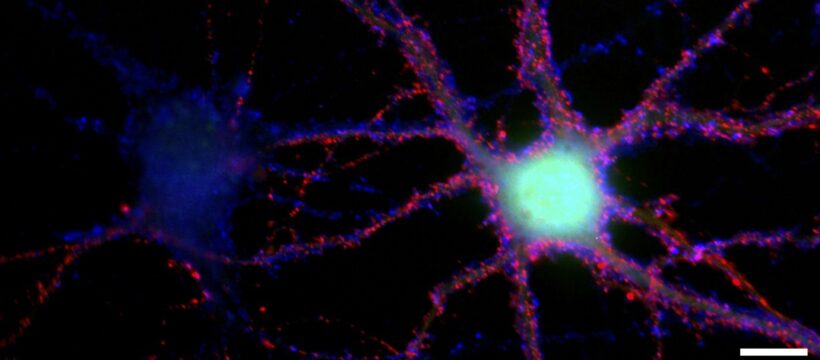Research at Karl Landsteiner University of Health Sciences offers new insight in brain connectivity and development.
Krems (Austria), 20. November 2024. A recent study has uncovered the intricate ways in which a rare genetic mutation impacts brain cell communication, providing critical insights into the causes of a severe neurological disorder known as developmental and epileptic encephalopathy (DEE). The findings reveal that this specific mutation in a regulatory calcium channel subunit disrupts both the calcium handling and structural connections of brain cells, expanding our understanding of how certain neurological conditions may arise. The work has now been published in the Journal of Neurochemistry and was conducted by a team at the at Karl Landsteiner University of Health Sciences (KL Krems).
Ion channels are critical for signal conduction in the nervous system, requiring precise regulation of their function. Proteins of the α2δ-family (pronounced „alpha-two-delta“) play a key role in this regulation. Acting as regulatory subunits of voltage-gated calcium channels, they have long been recognized for their role in modulating calcium currents —a key mechanism for enabling neurons to transmit and process electrical signals. Recent work also demonstrated that the α2δ-2 protein is essential for organizing the complex structural connections, or synapses, between neurons. Now researchers at the KL Krems are focused on a specific mutation of the gene CACNA2D2, which encodes α2δ-2.
A Dual Role in Neuronal Function
By examining the specific effects of the p.R593P mutation found in two siblings with DEE, the researchers were able to trace a detailed picture of the mutation’s dual impact on both calcium handling and structural aspects of neuron function. “Our findings reveal how this mutation disrupts the delicate interplay between calcium channels and the synaptic organization, which are both essential for normal brain function,” says Prof. Dr. Gerald Obermair, who heads the Division of Physiology at the Department of Pharmacology, Physiology, and Microbiology at the KL Krems and is the study’s lead investigator. “These disruptions provide an essential clue to understanding not only DEE but potentially a broader range of neurodevelopmental and neuropsychiatric disorders linked to α2δ proteins.”
The researchers used a homologous version of the human p.R593P mutation, p.R596P, to study its effects in mouse hippocampal neurons, which are critical for learning and memory. They discovered that the mutation drastically reduces α2δ-2’s surface expression and synaptic localization, which in turn disrupts multiple aspects of neuronal connectivity. These changes lead to an abnormal distribution of synaptic calcium channels and synaptic signalling molecules, resulting in impaired communication across synapses.
Three Changes Pinpointed
The study pinpointed three specific changes in synaptic function caused by the mutation. First, it impairs the trans-synaptic recruitment of postsynaptic GABAA receptors, which are vital for inhibitory signaling in the brain. Without effective inhibitory signaling, neurons become overactive, a hallmark of seizure conditions like DEE. Second, the mutation affects the clustering of synapsin, a protein essential for presynaptic structure in excitatory, glutamatergic synapses. Lastly, researchers noted a decrease in the amplitude of miniature postsynaptic currents, which reflects reduced synaptic strength and connectivity.
“These findings are significant because they demonstrate how a single gene mutation can ripple outwards, affecting multiple aspects of brain cell connectivity and potentially leading to widespread changes in brain function,” explains Sabrin Haddad, M.Sc., first author of the study’s publication and a PhD student in the team of Prof. Obermair at the KL Krems. “The disruption of these intricate signalling pathways and synaptic structures provides a potential explanation for the origins of the severe neurological symptoms in DEE patients.”
A Broader Path to Understanding Neurological Disorders
The discovery of these multi-layered impacts on both channel-related and synaptic functions highlights the need for research into “synaptopathies,” conditions that stem from disruptions in the physical and functional connections between neurons. By identifying these detailed molecular mechanisms, this study widens our understanding of brain connectivity and development. Ultimately it might open avenues for treatments and, by extension, improving synaptic connectivity and brain function.
Original publication: A biallelic mutation in CACNA2D2 associated with developmental and epileptic encephalopathy affects calcium channel-dependent as well as synaptic functions of α2δ-2. S. Haddad, C. Ablinger, R. Stanika, M. Hessenberger, M. Campiglio, N. J. Ortner, P. Tuluc, G. J. Obermair. Journal of Neurochemistry. 2024;00:1–24. https://kris.kl.ac.at/en/publications/a-biallelic-mutation-in-cacna2d2-associated-with-developmental-an
Images available on request
Karl Landsteiner University of Health Sciences (10/2024)
The Karl Landsteiner University of Health Sciences (KL Krems) is an educational and research institution on the Campus Krems and recognised throughout Europe. KL Krems offers modern, demand-oriented education and continuing education in medicine and psychology as well as a PhD programme in Mental Health and Neuroscience. The flexible educational programme is tailored to the needs of students, the requirements of the labour market and the challenges of science. The three university hospitals in Krems, St. Pölten and Tulln and the MedAustron Ion Therapy and Research Centre in Wiener Neustadt guarantee clinical teaching and research of the highest quality. In its research, KL Krems focuses on interdisciplinary fields with high relevance to health policy – including biomechanics, molecular oncology, mental health and neuroscience as well as the topic of water quality and the associated health aspects. KL Krems was founded in 2013 and accredited by the Austrian Agency for Quality Assurance and Accreditation (AQ Austria). https://www.kl.ac.at/en
Scientific Contact
Prof. Dr. Gerald Obermair
Division of Physiology
Department of Pharmacology, Physiology and Microbiology
Karl Landsteiner University of Health Sciences
Dr.-Karl-Dorrek-Straße 30
3500 Krems / Austria
T +43 2732 9004 12141
W https://www.kl.ac.at/
Karl Landsteiner University of Health Sciences
Mag. Selma Vrazalica, BA
Communications, PR & Marketing
Dr.-Karl-Dorrek-Straße 30
3500 Krems / Austria
T +43 2732 72090 237
M +43 664 883 99 603
Copy Editing & Distribution
PR&D – Public Relations for Research & Education
Dr. Barbara Bauder-Jelitto
Kollersteig 68
3400 Klosterneuburg / Austria
M +43 664 1576 350
L https://www.linkedin.com/company/prd-public-relations-für-forschung-bildung

